|
 Secure Site
Secure Site
|
 |
Archive for the 'Yoga Timers by Now & Zen' Category
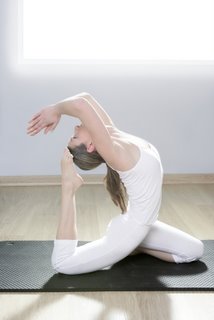 yoga and body & mind “A New Look” presents yoga as an evolutionary process and introduces the Yoga of Mind as a powerful approach to self-exploration. Mental yoga reveals the mind’s nature and its filters, and is an important part of physical yoga practice.
What is Yoga? There are as many answers to that question as there are people who do Yoga. This at first might appear confusing, for Yoga is often presented as if there were a true and fixed path to follow leading to a desired end. Enlightenment, samadhi, bliss, peace, higher realms of consciousness—these are the coins of the spiritual market place we are told we can collect with the proper practice and dedication.
To find the proper practice it is common to go back to the past, to tradition and authority. Perusing the past, however, there doesn’t appear to be any consensus for there were schools and counter-schools with recommendations running the gamut from demanding severe self-denial and austerities to others that held that only in experiencing life and sensuality to the fullest could true realization be achieved. The teachings of today are just as varied. One school says that all types of Yoga are contained within perfection of asanas, while others say that too much emphasis on the body keeps you limited to the gross material plane.
Tradition is important just as history is important —not as a vice to squeeze the present into, but rather as a stepping stone to grow from. It is necessary for all serious practitioners of Yoga to take from other people’s experience that which can be helpful to create a personal expression of Yoga. In the years that I have been exploring Yoga, an approach has taken form that has been continually revealing, renewing and exciting. The movement of Yoga involves among other things the continual living recreation of the question, “What is Yoga?” What follows is a brief introduction to the way I answer this question.
Yoga is a living process. The heart of Yoga does not lie in visible attainments; it lies in learning and exploring. Learning is a process, a movement, while attainments are static. One is internally learning about the whole field of life using the energy systems of one’s mind and body to find out how one works and how universal patterns express themselves through individuals. Yoga also involves the process of freeing one’s energy, moving out of the blocks and binds that limit one both physically and mentally. Freeing oneself is part of the process of self-knowledge for one’s binds limit the nature of the exploration, just as releasing them permits learning to occur.
The way freedom is usually talked about is freedom from something: freedom from pain, fear, death, aging, disease, from sorrow, attachment, and of course, from the ego or self which is viewed as the source of all problems. The bondage of flesh and the tyranny of mind as they endlessly create desire, are to be overcome through discipline. Yet anyone who tries to do this necessarily confronts the basic paradox that is a part of the spiritual quest: trying to free oneself from anything contains within it the seeds of the very bondage one is trying to escape. The desire to be desireless is another desire. The push to conquer one’s ego in the belief that ego loss will be the ultimate experience bringing perfection is self-centered activity. The desire for ego loss and perfection comes from the ego as does all desire.
Thought then creates ideas of perfection from second-handed sources or from memory’s projections and strives toward their accomplishment which is more ego activity. This is another example of what I call the spiritual paradox. If freedom is looked at as a dimension of action rather than as an escape from something, as a living process instead of a goal, the spiritual paradox dissolves. The only real freedom is freedom in action. Freedom is responding totally to the challenges of the living moment.
The true spiritual quest is not “How do I become free?” but rather, “What is it that binds me?” The most important thing about questing or questioning is the nature of the quest or question. Asking “How do I become free?” automatically places you in the spiritual paradox, and even more important, is not answerable. For questing after freedom always involves ideas about what freedom consists of. The ideas I have, come from the state of not being free, and therefore involve projections of what it would be like not to have the problems that I have. Freedom here again is freedom from something—fear, jealousy, competitiveness whatever. The very ideas I have of freedom are limited by the state of my consciousness and as I try to force myself into the mold of the idea or ideal, I am limiting freedom right at the start. So I can never find out how to be free by seeking freedom. I can, however, find out the nature of what it is that limits my awareness and the scope of my responsiveness because that can be directly perceived.
The body’s potential responsiveness is limited by stiffness, lack of strength and endurance. The mind’s responsiveness is limited by the way it thinks about things. The ideas and beliefs through which you view the world necessarily keep you within the field of these thought structures. The way that you think about things totally influences not only the way you act, but the way you perceive.
If, for example, you think that thought is the villain preventing you from experiencing the “now” and therefore must be conquered through meditation, that mind-set influences everything you do. In intellectual circles there is the tendency to greatly value thought; in spiritual circles there is a tendency to judge thought negatively. The interesting thing is that both evaluations are just thought judging itself. Yoga is the process by which I find out the nature of my binds and keep in touch with those aspects of life that limit freedom. I have found that a synthesis of two traditional approaches of Yoga is the most direct route to this exploration. Hatha, the physical Yoga, and Jnana, the mental Yoga, both deal with discovering the limits that conditioning imposes. No conditioning is just physical or just mental. How we think is a part of how we feel and, of course, how we feel influences the thought process.
The term “conditioning” here refers to habits of the mind and body which are programmed in through experience. This includes genetic conditioning which is also programmed in through experience, although the experience is of a different order. Yoga then is the exploration of one’s total conditioning, Hatha Yoga using the body as the doorway, and Jnana Yoga using the mind. I am not presenting conditioning as a new villain to be conquered. Conditioning is part of the organizational principal of universal energy which builds patterns and systems that are the stuff of life. Conditioning is a fact which actually aids the movement of life, for without it there would be no life.
At the same time conditioning is a hindrance to freedom since habits also constrict by channeling the new into old patterns, by creating and reinforcing the tendency to go on automatic which limits awareness, and by creating attachments to familiar pleasures and securities which block real change. Freedom does not lie in negating or overcoming the fact of conditioning which is impossible, but rather in springing, in the living moment, from those patterns that limit the field of what is possible.
In Hatha Yoga what is possible in any posture is a function of your conditioning (including what you ate yesterday). If instead of trying to force yourself into the idealized final position, you use the posture to explore the limitations imposed by conditioning, there is automatically a relaxation in mind and body. The postures then become highly refined tools to approach the edge or limit that binds you. Awarely playing at the edge of conditioning changes the field of what is possible.
Yoga is a process of opening, of moving beyond the physical and conceptual limits of conditioning. Experience by its nature conditions, so that moving out of it is an endless process. There is no mastery of yoga since one can only master that which has an end. The concept of opening, however, can slyly become just another idealized goal to be achieved. Actually, awareness of the tendency of the very nature of thought to stop process is part of what Jnana Yoga is about.
A key to the process of opening that keeps you truly opened is what I call “playing the edge.” The body’s edge in Yoga is the place just before pain, but not pain itself. Pain tells you where the limits of physical conditioning lie. Since the edge moves from day to day and from breath to breath (not always forward), in order to be right there, moving with its often subtle changes, you must be very alert. This quality of alertness which is a meditative state is at the heart of Yoga. A great danger in Hatha Yoga is going on automatic so that the postures become mechanical exercises, bringing with them dullness, fatigue, and resistance to doing Yoga at all. Just as the mind is more elusive than the body, so the edge in Jnana Yoga is not as obvious as in Hatha.
The habits of mind that have accumulated over time continually reinforce themselves. Habits of mind are repetitive ways of thinking about things and of structuring the world in such mental patterns as beliefs, values, fears, hopes, ambitions, self images, images of others and of the universe itself. For instance, whether I view the universe as either basically benign, ma levolent or neutral (indifferent) seems to be an abstraction far removed from daily living that I might seldom overtly think about.
These world views, however, are the basis of common attitudes (idealism, cynicism, skepticism) which are patterns that color all perceptions by monitoring what comes in, and directly affect day to day life. How does one play the edge of thought? In Hatha Yoga, the Yoga is in the quality of attention to the physical system so that one learns to listen to what the messages of the body are saying. The muscles, tendons, nerves, glands, and organ systems have their own intelligence and information processing networks that can be tuned into and learned from. Playing on the edge physically sharpens the ability of the total organism to interpret and integrate this information.
Thought also manifests in systems which are set ways of thinking about a particular segment of one’s life. These systems are sometimes in harmony with each other but often not. Each role or pattern in one’s life has a thought structure or system that gives life to and perpetuates the behavior. Hatha Yoga stretches and strengthens one physically so that one has a stronger and more flexible body. Similarly Jnana Yoga stretches and strengthens one mentally so that one can use the structures that thought builds creatively and harmoniously, and yet not be bound by the limits that thought places on life. Mental edges are similar to physical edges in that they are marked by resistance to movement and opening. In the mind, fear is the indicator of resistance as pain is in the body.
Fear circumscribes the structure of personality or ego. The ways you think about yourself or the world are the basic building blocks of personality and they are very rigid. When these structures are challenged, fear arises. Fear often expresses itself through attack and defense as a means of alleviating the pain that fear brings. Attack and defense are a way of shoring up (protecting) the challenged structure and burying fear in what is called the unconscious, giving you the illusion of not being afraid. Fear is a great teacher since it is a key to finding out the nature, depth, and degree of your attachment to various thought structures. In Hatha Yoga, as you awarely play the edge of what is physically possible, your edge moves. What is possible has changed—you have changed. There is more flexibility, more openness in the tissue, and correspondingly more energy. As Jnana Yoga plays the edges of mental resistance, the very doing of this moves the edge, enlarging the limits of what is possible. This is really what expanding consciousness is all about.
A major difficulty in Jnana Yoga is that since your mental edges define the way you perceive, the very perception of where your edges or conditionings are is limited by your present perception: if I try to look at the way that I look at things, the way I do it is the way that I look at things. How I look at things at any given moment is me. Another problem of Jnana Yoga is that there is no set body of techniques corresponding to asanas to use to play your mental edges. In Hatha Yoga the asanas are necessary because in living you rarely challenge or even reach your physical edges.
You are, however, confronting your mental edges on a day to day basis whether you want to or not, so that mechanical technique is not necessary. In Hatha Yoga the demands of a given posture, the immediacy of the feedback of physical pain, the possibility of injury through carelessness, the proper use of breath, can aid in bringing forth the necessary attention. In Jnana Yoga, attention is also the key. To find out how thought works, it is necessary to pay attention to the forms it takes: words, sentences, images.
It is also very important to be aware of where your attention is at any given moment. Your attention at any moment is what you are at that moment and this directly reveals your conditioning. Being aware of the movement of attention is actually a meditative process that shifts consciousness. The resulting sense of distance and quality of detachment permit an objectivity that is not bound by the structures of thought. This objectivity is the source of newness and creativity, bringing a sense of awe that transcends the merely personal. It can also bring fear. Since we hold the world and ourselves together with thought, real objectivity can challenge the fabric of our lives bringing resistance and fear. This very fear is an indication of the existence of mental conditioning and paying attention to it (playing the edge of it) “stretches” it in a somewhat similar way as awarely playing the edge of pain stretches the body.
Although Jnana Yoga cannot be practiced in the ordinary sense, (“practice” usually means repetition toward the accumulation of desired habits), one may “practice” Jnana Yoga by simply sitting quietly, observing the inner panorama. An advantage of sitting quietly is temporary removal from external reactions that permits more ready access to thought. Sitting also allows what has been repressed by thought or inattention to bubble up. Since one’s mental edges display themselves in the relationships of daily life, with people, ideas, the physical environment, so the “practice” of Jnana Yoga can and does occur not only during formal sitting, but in all aspects of life.
One might mistake attention for continually trying to figure out what’s going on inside which can end up in paralysis or in removal from living. Attention is not an analytical process involving brain activity. It is a simple registering of what is happening so that there is no “figuring out” involved. Trying to be attentive does remove one from what is going on and therefore is not attention.
One does not do Jnana Yoga by trying to force attention to the structures of thought to find out what thought’s limits are. Since the edges are there, one does not have to seek them. A thought, although more elusive, is as much a fact as a bird or a tree, so all it takes to see it is objectively looking. The simplicity of Jnana Yoga is made difficult in that the brain is so conditioned by thought and so habit—bound in its mental structures that the shift of consciousness from thought to attention at first sounds mysterious.
When thought thinks about this shift either through reading about it or by remembering a previous occurrence of it, thought tries to bring about this shift. This is impossible as the shift does not occur within the field of thought. Yet this quality of attention, this shift in consciousness, is available at any instant, for one can be attentive even to the fact of one’s inattention. You only really learn Hatha Yoga by getting on the floor and doing it. You learn about Jana Yoga by doing it, too.
Even though the learning is not a mechanical accumulation of skills, you can learn about the nature of the mental processes, which are mechanical, that keep this shift in consciousness from happening. The very doing of this allows the shift to occur. Although I have presented Hatha and Jnana Yoga as separate, ultimately they are not, for each complements and completes the other. I have found that Jnana Yoga is not only helpful in doing Hatha Yoga, but necessary.
Hatha Yoga is a miniature universe containing within it in its own form all of the problems of so-called ordinary life: ambition, image making, the subtle or not so subtle intrusion of comparison and competition, the pleasures of accomplishment, the dislike of regression, the frustrations of not having expectations met, and of course, the potentially ever-recurring specter of fear. Fear of aging, of dying, of one’s own sloth and laziness, of not measuring up to standards, of not making it (whatever “it” is) —these and other aspects of life display themselves in Hatha Yoga in a particularly direct and poignant way. Awareness of the structures of thought that come out of physical exploring is an integral part of the process of exploring the body. In exploring mental conditioning you find that psychological tightness conditions and tightens the body.
The common phrase “up tight” is ordinarily used to describe a mental state. When you are up tight you can notice how the body is also physically tightening. These habitual body tensions that over years bring about stiffness are the repository of internalized mental states. Opening up in physical Yoga opens you up mentally and opening up mentally aids in the opening of the body. I look upon Hatha and Jnana Yoga as two sides of a coin, as mirror images of each other. They are different routes of exploring what it is to be a human being.
Many features of other traditional approaches to Yoga such as Karma Yoga (the yoga of action in the world) and Raja Yoga (which is Patanjali’s specific combination of different Yogas) are incorporated in this approach. Tantric Yoga, which traditionally is a blending or merging of the male and female, can involve an edge playing in relationship which reveals other aspects of conditioning.
Bhakti or the devotional aspects of Yoga that involve a surrender to what is, comes out of a deep seeing of how the universe works. Serious people within an historical epoch have always re-examined and redefined the thrust of importance—which later becomes tradition, to be redefined again as times and the movement of consciousness evolve. The way I have answered the question “What is Yoga?” is in one sense not traditional. Yoga has always been a synthesis of personal experience and tradition—a blend of the new and the old. Indeed, an integral part of the tradition of Yoga is to be continually reinterpreting what Yoga is. It is this flexibility at the heart of Yoga which has allowed Yoga to be meaningful for thousands of years.
adapted from Yoga Journal by Joel Kramer and Diana Alstad.
 zen clocks and yoga timers with chimes and tibetan bowls Now & Zen
1638 Pearl Street
Boulder, CO 80302
(800) 779-6383
Posted in yoga, Yoga Timer, Yoga Timers by Now & Zen
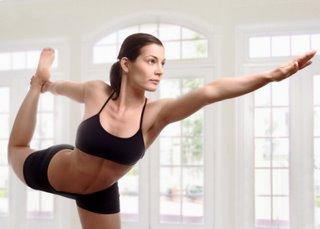 Expert yoga pose Are you looking for reasons to start practicing? Here are ways yoga improves your health—reasons enough to roll out the mat and get started.
If you’re a passionate yoga practitioner, you’ve probably noticed the ways yoga works—maybe you’re sleeping better or getting fewer colds or just feeling more relaxed and at ease. But if you’ve ever tried telling a newbie how it works, you might find that explanations like “It increases the flow of prana” or “It brings energy up your spine” fall on deaf or skeptical ears.
As it happens, Western science is starting to provide some concrete clues as to how yoga works to improve health, heal aches and pains, and keep sickness at bay. Once you understand them, you’ll have even more motivation to step onto your mat, and you probably won’t feel so tongue-tied the next time someone wants Western proof.
I myself have experienced yoga’s healing power in a very real way. Weeks before a trip to India in 2002 to investigate yoga therapy, I developed numbness and tingling in my right hand. After first considering scary things like a brain tumor and multiple sclerosis, I figured out that the cause of the symptoms was thoracic outlet syndrome, a nerve blockage in my neck and chest.
Despite the uncomfortable symptoms, I realized how useful my condition could be during my trip. While visiting various yoga therapy centers, I would submit myself for evaluation and treatment by the various experts I’d arranged to observe. I could try their suggestions and see what worked for me. While this wasn’t exactly a controlled scientific experiment, I knew that such hands-on learning could teach me things I might not otherwise understand.
My experiment proved illuminating. At the Vivekananda ashram just outside of Bangalore, S. Nagarathna, M.D., recommended breathing exercises in which I imagined bringing prana (vital energy) into my right upper chest. Other therapy included asana, pranayama, meditation, chanting, lectures on philosophy, and various kriya (internal cleansing practices). At the Krishnamacharya Yoga Mandiram in Chennai and from A.G. Mohan and his wife, Indra, who practice just outside of Chennai, I was told to stop practicing Headstand and Shoulderstand in favor of gentle asana coordinated with the breath. In Pune, S.V. Karandikar, a medical doctor, recommended practices with ropes and belts to put traction on my spine and exercises that taught me to use my shoulder blades to open my upper back.
Thanks to the techniques I learned in India, advice from teachers in the United States, and my own exploration, my chest is more flexible than it was, my posture has improved, and for more than a year, I’ve been free of symptoms.
My experience inspired me to pore over the scientific studies I’d collected in India as well as the West to identify and explain how yoga can both prevent disease and help you recover from it. Here is what I found.
| Flex Time |
| 1 Improved flexibility is one of the first and most obvious benefits of yoga. During your first class, you probably won’t be able to touch your toes, never mind do a backbend. But if you stick with it, you’ll notice a gradual loosening, and eventually, seemingly impossible poses will become possible. You’ll also probably notice that aches and pains start to disappear. That’s no coincidence. Tight hips can strain the knee joint due to improper alignment of the thigh and shinbones. Tight hamstrings can lead to a flattening of the lumbar spine, which can cause back pain. And inflexibility in muscles and connective tissue, such as fascia and ligaments, can cause poor posture. |
Strength Test
2 Strong muscles do more than look good. They also protect us from conditions like arthritis and back pain, and help prevent falls in elderly people. And when you build strength through yoga, you balance it with flexibility. If you just went to the gym and lifted weights, you might build strength at the expense of flexibility.
| Standing Orders |
| 3 Your head is like a bowling ball—big, round, and heavy. When it’s balanced directly over an erect spine, it takes much less work for your neck and back muscles to support it. Move it several inches forward, however, and you start to strain those muscles. Hold up that forward-leaning bowling ball for eight or 12 hours a day and it’s no wonder you’re tired. And fatigue might not be your only problem. Poor posture can cause back, neck, and other muscle and joint problems. As you slump, your body may compensate by flattening the normal inward curves in your neck and lower back. This can cause pain and degenerative arthritis of the spine. |
Joint Account
4 Each time you practice yoga, you take your joints through their full range of motion. This can help prevent degenerative arthritis or mitigate disability by “squeezing and soaking” areas of cartilage that normally aren’t used. Joint cartilage is like a sponge; it receives fresh nutrients only when its fluid is squeezed out and a new supply can be soaked up. Without proper sustenance, neglected areas of cartilage can eventually wear out, exposing the underlying bone like worn-out brake pads.
Spinal Rap
5 Spinal disks—the shock absorbers between the vertebrae that can herniate and compress nerves—crave movement. That’s the only way they get their nutrients. If you’ve got a well-balanced asana practice with plenty of backbends, forward bends, and twists, you’ll help keep your disks supple.
Bone Zone
6 It’s well documented that weight-bearing exercise strengthens bones and helps ward off osteoporosis. Many postures in yoga require that you lift your own weight. And some, like Downward- and Upward-Facing Dog, help strengthen the arm bones, which are particularly vulnerable to osteoporotic fractures. In an unpublished study conducted at California State University, Los Angeles, yoga practice increased bone density in the vertebrae. Yoga’s ability to lower levels of the stress hormone cortisol (see Number 11) may help keep calcium in the bones.
Flow Chart
7 Yoga gets your blood flowing. More specifically, the relaxation exercises you learn in yoga can help your circulation, especially in your hands and feet. Yoga also gets more oxygen to your cells, which function better as a result. Twisting poses are thought to wring out venous blood from internal organs and allow oxygenated blood to flow in once the twist is released. Inverted poses, such as Headstand, Handstand, and Shoulderstand, encourage venous blood from the legs and pelvis to flow back to the heart, where it can be pumped to the lungs to be freshly oxygenated. This can help if you have swelling in your legs from heart or kidney problems. Yoga also boosts levels of hemoglobin and red blood cells, which carry oxygen to the tissues. And it thins the blood by making platelets less sticky and by cutting the level of clot-promoting proteins in the blood. This can lead to a decrease in heart attacks and strokes since blood clots are often the cause of these killers.
Lymph Lesson
8 When you contract and stretch muscles, move organs around, and come in and out of yoga postures, you increase the drainage of lymph (a viscous fluid rich in immune cells). This helps the lymphatic system fight infection, destroy cancerous cells, and dispose of the toxic waste products of cellular functioning.
Heart Start
9 When you regularly get your heart rate into the aerobic range, you lower your risk of heart attack and can relieve depression. While not all yoga is aerobic, if you do it vigorously or take flow or Ashtanga classes, it can boost your heart rate into the aerobic range. But even yoga exercises that don’t get your heart rate up that high can improve cardiovascular conditioning. Studies have found that yoga practice lowers the resting heart rate, increases endurance, and can improve your maximum uptake of oxygen during exercise—all reflections of improved aerobic conditioning. One study found that subjects who were taught only pranayama could do more exercise with less oxygen.
Pressure Drop
10 If you’ve got high blood pressure, you might benefit from yoga. Two studies of people with hypertension, published in the British medical journal The Lancet, compared the effects of Savasana (Corpse Pose) with simply lying on a couch. After three months, Savasana was associated with a 26-point drop in systolic blood pressure (the top number) and a 15-point drop in diastolic blood pressure (the bottom number—and the higher the initial blood pressure, the bigger the drop.
Worry Thwarts
11 Yoga lowers cortisol levels. If that doesn’t sound like much, consider this. Normally, the adrenal glands secrete cortisol in response to an acute crisis, which temporarily boosts immune function. If your cortisol levels stay high even after the crisis, they can compromise the immune system. Temporary boosts of cortisol help with long-term memory, but chronically high levels undermine memory and may lead to permanent changes in the brain. Additionally, excessive cortisol has been linked with major depression, osteoporosis (it extracts calcium and other minerals from bones and interferes with the laying down of new bone), high blood pressure, and insulin resistance. In rats, high cortisol levels lead to what researchers call “food-seeking behavior” (the kind that drives you to eat when you’re upset, angry, or stressed). The body takes those extra calories and distributes them as fat in the abdomen, contributing to weight gain and the risk of diabetes and heart attack.
| Happy Hour |
| 12 Feeling sad? Sit in Lotus. Better yet, rise up into a backbend or soar royally into King Dancer Pose. While it’s not as simple as that, one study found that a consistent yoga practice improved depression and led to a significant increase in serotonin levels and a decrease in the levels of monoamine oxidase (an enzyme that breaks down neurotransmitters) and cortisol. At the University of Wisconsin, Richard Davidson, Ph.D., found that the left prefrontal cortex showed heightened activity in meditators, a finding that has been correlated with greater levels of happiness and better immune function. More dramatic left-sided activation was found in dedicated, long-term practitioners. |
Weighty Matters
13 Move more, eat less—that’s the adage of many a dieter. Yoga can help on both fronts. A regular practice gets you moving and burns calories, and the spiritual and emotional dimensions of your practice may encourage you to address any eating and weight problems on a deeper level. Yoga may also inspire you to become a more conscious eater.
Low Show
14 Yoga lowers blood sugar and LDL (“bad”) cholesterol and boosts HDL (“good”) cholesterol. In people with diabetes, yoga has been found to lower blood sugar in several ways: by lowering cortisol and adrenaline levels, encouraging weight loss, and improving sensitivity to the effects of insulin. Get your blood sugar levels down, and you decrease your risk of diabetic complications such as heart attack, kidney failure, and blindness.
| Brain Waves |
| 15 An important component of yoga is focusing on the present. Studies have found that regular yoga practice improves coordination, reaction time, memory, and even IQ scores. People who practice Transcendental Meditation demonstrate the ability to solve problems and acquire and recall information better—probably because they’re less distracted by their thoughts, which can play over and over like an endless tape loop. |
Nerve Center
16 Yoga encourages you to relax, slow your breath, and focus on the present, shifting the balance from the sympathetic nervous system (or the fight-or-flight response) to the parasympathetic nervous system. The latter is calming and restorative; it lowers breathing and heart rates, decreases blood pressure, and increases blood flow to the intestines and reproductive organs—comprising what Herbert Benson, M.D., calls the relaxation response.
Space Place
17 Regularly practicing yoga increases proprioception (the ability to feel what your body is doing and where it is in space) and improves balance. People with bad posture or dysfunctional movement patterns usually have poor proprioception, which has been linked to knee problems and back pain. Better balance could mean fewer falls. For the elderly, this translates into more independence and delayed admission to a nursing home or never entering one at all. For the rest of us, postures like Tree Pose can make us feel less wobbly on and off the mat.
Control Center
18 Some advanced yogis can control their bodies in extraordinary ways, many of which are mediated by the nervous system. Scientists have monitored yogis who could induce unusual heart rhythms, generate specific brain-wave patterns, and, using a meditation technique, raise the temperature of their hands by 15 degrees Fahrenheit. If they can use yoga to do that, perhaps you could learn to improve blood flow to your pelvis if you’re trying to get pregnant or induce relaxation when you’re having trouble falling asleep.
Loose Limbs
19 Do you ever notice yourself holding the telephone or a steering wheel with a death grip or scrunching your face when staring at a computer screen? These unconscious habits can lead to chronic tension, muscle fatigue, and soreness in the wrists, arms, shoulders, neck, and face, which can increase stress and worsen your mood. As you practice yoga, you begin to notice where you hold tension: It might be in your tongue, your eyes, or the muscles of your face and neck. If you simply tune in, you may be able to release some tension in the tongue and eyes. With bigger muscles like the quadriceps, trapezius, and buttocks, it may take years of practice to learn how to relax them.
Chill Pill
20 Stimulation is good, but too much of it taxes the nervous system. Yoga can provide relief from the hustle and bustle of modern life. Restorative asana, yoga nidra (a form of guided relaxation), Savasana, pranayama, and meditation encourage pratyahara, a turning inward of the senses, which provides downtime for the nervous system. Another by-product of a regular yoga practice, studies suggest, is better sleep—which means you’ll be less tired and stressed and less likely to have accidents.
Immune Boon
21 Asana and pranayama probably improve immune function, but, so far, meditation has the strongest scientific support in this area. It appears to have a beneficial effect on the functioning of the immune system, boosting it when needed (for example, raising antibody levels in response to a vaccine) and lowering it when needed (for instance, mitigating an inappropriately aggressive immune function in an autoimmune disease like psoriasis).
Breathing Room
22 Yogis tend to take fewer breaths of greater volume, which is both calming and more efficient. A 1998 study published in The Lancet taught a yogic technique known as “complete breathing” to people with lung problems due to congestive heart failure. After one month, their average respiratory rate decreased from 13.4 breaths per minute to 7.6. Meanwhile, their exercise capacity increased significantly, as did the oxygen saturation of their blood. In addition, yoga has been shown to improve various measures of lung function, including the maximum volume of the breath and the efficiency of the exhalation. Yoga also promotes breathing through the nose, which filters the air, warms it (cold, dry air is more likely to trigger an asthma attack in people who are sensitive), and humidifies it, removing pollen and dirt and other things you’d rather not take into your lungs.
Poop Scoop
23 Ulcers, irritable bowel syndrome, constipation—all of these can be exacerbated by stress. So if you stress less, you’ll suffer less. Yoga, like any physical exercise, can ease constipation—and theoretically lower the risk of colon cancer—because moving the body facilitates more rapid transport of food and waste products through the bowels. And, although it has not been studied scientifically, yogis suspect that twisting poses may be beneficial in getting waste to move through the system.
Peace of Mind
24 Yoga quells the fluctuations of the mind, according to Patanjali’s Yoga Sutra. In other words, it slows down the mental loops of frustration, regret, anger, fear, and desire that can cause stress. And since stress is implicated in so many health problems—from migraines and insomnia to lupus, MS, eczema, high blood pressure, and heart attacks—if you learn to quiet your mind, you’ll be likely to live longer and healthier.
Divine Sign
25 Many of us suffer from chronic low self-esteem. If you handle this negatively—take drugs, overeat, work too hard, sleep around—you may pay the price in poorer health physically, mentally, and spiritually. If you take a positive approach and practice yoga, you’ll sense, initially in brief glimpses and later in more sustained views, that you’re worthwhile or, as yogic philosophy teaches, that you are a manifestation of the Divine. If you practice regularly with an intention of self-examination and betterment—not just as a substitute for an aerobics class—you can access a different side of yourself. You’ll experience feelings of gratitude, empathy, and forgiveness, as well as a sense that you’re part of something bigger. While better health is not the goal of spirituality, it’s often a by-product, as documented by repeated scientific studies.
Pain Drain
26 Yoga can ease your pain. According to several studies, asana, meditation, or a combination of the two, reduced pain in people with arthritis, back pain, fibromyalgia, carpal tunnel syndrome, and other chronic conditions. When you relieve your pain, your mood improves, you’re more inclined to be active, and you don’t need as much medication.
Heat Treatment
27 Yoga can help you make changes in your life. In fact, that might be its greatest strength. Tapas, the Sanskrit word for “heat,” is the fire, the discipline that fuels yoga practice and that regular practice builds. The tapas you develop can be extended to the rest of your life to overcome inertia and change dysfunctional habits. You may find that without making a particular effort to change things, you start to eat better, exercise more, or finally quit smoking after years of failed attempts.
Guru Gifts
28 Good yoga teachers can do wonders for your health. Exceptional ones do more than guide you through the postures. They can adjust your posture, gauge when you should go deeper in poses or back off, deliver hard truths with compassion, help you relax, and enhance and personalize your practice. A respectful relationship with a teacher goes a long way toward promoting your health.
Drug Free
29 If your medicine cabinet looks like a pharmacy, maybe it’s time to try yoga. Studies of people with asthma, high blood pressure, Type II diabetes (formerly called adult-onset diabetes), and obsessive-compulsive disorder have shown that yoga helped them lower their dosage of medications and sometimes get off them entirely. The benefits of taking fewer drugs? You’ll spend less money, and you’re less likely to suffer side effects and risk dangerous drug interactions.
Hostile Makeover
30 Yoga and meditation build awareness. And the more aware you are, the easier it is to break free of destructive emotions like anger. Studies suggest that chronic anger and hostility are as strongly linked to heart attacks as are smoking, diabetes, and elevated cholesterol. Yoga appears to reduce anger by increasing feelings of compassion and interconnection and by calming the nervous system and the mind. It also increases your ability to step back from the drama of your own life, to remain steady in the face of bad news or unsettling events. You can still react quickly when you need to—and there’s evidence that yoga speeds reaction time—but you can take that split second to choose a more thoughtful approach, reducing suffering for yourself and others.
Good Relations
31 Love may not conquer all, but it certainly can aid in healing. Cultivating the emotional support of friends, family, and community has been demonstrated repeatedly to improve health and healing. A regular yoga practice helps develop friendliness, compassion, and greater equanimity. Along with yogic philosophy’s emphasis on avoiding harm to others, telling the truth, and taking only what you need, this may improve many of your relationships.
Sound System
32 The basics of yoga—asana, pranayama, and meditation—all work to improve your health, but there’s more in the yoga toolbox. Consider chanting. It tends to prolong exhalation, which shifts the balance toward the parasympathetic nervous system. When done in a group, chanting can be a particularly powerful physical and emotional experience. A recent study from Sweden’s Karolinska Institute suggests that humming sounds—like those made while chanting Om—open the sinuses and facilitate drainage.
Vision Quest
33 If you contemplate an image in your mind’s eye, as you do in yoga nidra and other practices, you can effect change in your body. Several studies have found that guided imagery reduced postoperative pain, decreased the frequency of headaches, and improved the quality of life for people with cancer and HIV.
Clean Machine
34 Kriyas, or cleansing practices, are another element of yoga. They include everything from rapid breathing exercises to elaborate internal cleansings of the intestines. Jala neti, which entails a gentle lavage of the nasal passages with salt water, removes pollen and viruses from the nose, keeps mucus from building up, and helps drains the sinuses.
Karma Concept
35 Karma yoga (service to others) is integral to yogic philosophy. And while you may not be inclined to serve others, your health might improve if you do. A study at the University of Michigan found that older people who volunteered a little less than an hour per week were three times as likely to be alive seven years later. Serving others can give meaning to your life, and your problems may not seem so daunting when you see what other people are dealing with.
Healing Hope
36 In much of conventional medicine, most patients are passive recipients of care. In yoga, it’s what you do for yourself that matters. Yoga gives you the tools to help you change, and you might start to feel better the first time you try practicing. You may also notice that the more you commit to practice, the more you benefit. This results in three things: You get involved in your own care, you discover that your involvement gives you the power to effect change, and seeing that you can effect change gives you hope. And hope itself can be healing.
Connective Tissue
37 As you read all the ways yoga improves your health, you probably noticed a lot of overlap. That’s because they’re intensely interwoven. Change your posture and you change the way you breathe. Change your breathing and you change your nervous system. This is one of the great lessons of yoga: Everything is connected—your hipbone to your anklebone, you to your community, your community to the world. This interconnection is vital to understanding yoga. This holistic system simultaneously taps into many mechanisms that have additive and even multiplicative effects. This synergy may be the most important way of all that yoga heals.
Placebo Power
38 Just believing you will get better can make you better. Unfortunately, many conventional scientists believe that if something works by eliciting the placebo effect, it doesn’t count. But most patients just want to get better, so if chanting a mantra—like you might do at the beginning or end of yoga class or throughout a meditation or in the course of your day—facilitates healing, even if it’s just a placebo effect, why not do it?
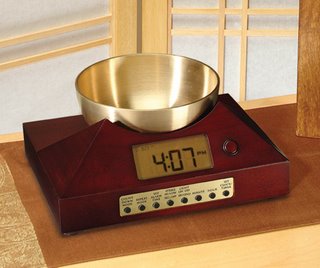 Yoga Timer and Clock with Tibetan Bowl Adapted from Yoga Journal by Timothy McCall, M.D., is Yoga Journal’s medical editor and a board-certified specialist in internal medicine. His book Yoga as Medicine will be released in fall 2005. Check with your health care provider before following any of the recommendations given in this article.
Now & Zen
1638 Pearl Street
Boulder, CO 80302
(800) 779-6383
Posted in yoga, Yoga Timer, Yoga Timers by Now & Zen
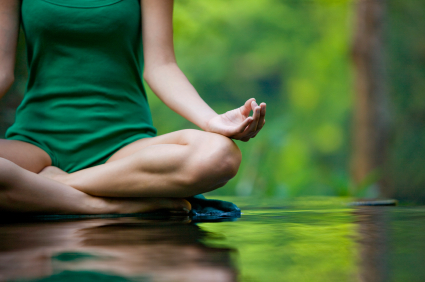 yoga and diet Yoga offers the inner harmony and body awareness required to achieve a healthier approach to eating. All that, and a leaner, stronger body too.
Lanita Varshell is a round, vibrant woman with a zest for life, a joyful smile, a gentle voice, and a passion for teaching yoga to women with weight issues. But Varshell wasn’t always this spirited or committed to yoga. Six years ago, she was incapacitated by fibromyalgia and chronic fatigue syndrome and could barely care for her two young children. Pain and exhaustion forced her to quit her full-time job. At 5 feet 3 1/2 inches and 240 pounds, she was a self-described “couch potato.”
“I’d been obsessed with dieting since I was 10 years old,” Varshell, now 43, says. “I had a history of joining gyms, then quitting. I’d diet, lose 20 or 30 pounds, then gain 40 or 50 back.” Though she’d heard about a gentle yoga class in her area, she procrastinated for six months. When she finally got the courage to attend, the experience touched her on a deep level. “Doing the poses brought tears to my eyes. For the first time in my life, I made a loving connection with my body,” she says. “Before that, my body was always my curse.”
In the years since, Varshell has lost 30 pounds as a direct result of practicing yoga. Increased body awareness has changed her eating habits, and the inner quiet has helped her explore emotional issues she once buried by eating. “Yoga helps you love yourself regardless of extra weight or imperfections,” she states. “I’ve let go of dieting—’die-eating’ to me—and now focus on health. If I keep on the yoga path, weight loss will continue to happen slowly and naturally. Healing weight challenges through yoga is like taking the scenic route instead of the main highway. It’s slower, but much more enjoyable and lasting.”
Although still challenged with fibromyalgia, Varshell’s health and energy have dramatically improved, and she runs her own yoga studio, A Gentle Way Yoga, in San Diego and La Mesa, California, where she teaches very gentle yoga, chair yoga for seniors, traditional hatha yoga, and yoga for super-sized people. Her yoga audiotape, A Gentle Way, disseminates her “gently-does-it” message. Many of her students attribute weight loss to their yoga practice, though Varshell reports that these students don’t obsess about weight as they once did, even if they are still carrying extra pounds. “Now body/mind/spirit health is their—and my—primary focus,” she says. “We’ve become committed to finding out what it means to be healthy—not just thin. Yoga has taught us to appreciate our bodies at any size.”
Varshell’s story inspires me, because I too struggle with my weight. Like her, I think yoga is a wonderful, holistic way to approach the underlying causes of excess fat, which are often a complex mix of physical, emotional, and spiritual issues. Of course, most people associate yoga with skinny, ultra-flexible yogis, not well-padded bodies with Buddha bellies. That’s a shame, because people of girth need yoga as much as—or more than—anyone. For those who, like me, have a tough time with overeating, junk food addiction, unwanted pounds, and the shame that accompanies being less than svelte, yoga offers the peace of mind and body awareness required to achieve a healthier approach to eating. All that, and a leaner, stronger body too.
As my weight has crept higher over the past three years, my self-esteem has sunk lower, leaving me feeling depressed, inferior, and weak-willed. As I increasingly relied on food to bolster me through stressful or unhappy times, I lost confidence in my body, which seemed to betray me. My arches hurt, my back ached, I panted going up steps, I broke my foot. I knew yoga had helped me feel strong and relaxed in the past, but I was too humiliated to do it in such bad shape.
Finally, a few months ago, I started watching gentle yoga videos at home. I remember sobbing on the floor when my barely healed foot couldn’t hold me in Downward-Facing Dog, so I quit. Weeks passed, and a friend invited me to a beginning yoga class. I went, determined not to expect miracles. After one class, something inside me shifted. Next thing I knew, I’d signed up for private sessions with the yoga teacher to work on modifying poses. At the same time, I started making dietary changes. After a month of doing yoga three or four times a week, my flexibility was returning, and I was ecstatic the day I held Tree Pose while balanced on my weak foot.
I’d been so excited about my new strength—which improves weekly—that I paid little attention to the scale, although I dropped a trouser size in a month. Part of my 15-pound weight loss resulted from all those fruits and veggies, but the experience taught me that yoga and other weight-loss measures are perfect partners. Making any lifestyle change is achingly slow, so what better way to practice patience than through yoga?
Keep in mind that achieving and maintaining a healthy body weight has benefits other than appearance, since excess body fat puts you at serious risk for a number of health problems. If your body fat percentage is greater than 30 percent for women or 25 percent for men, your risk of developing diabetes, heart disease, high blood pressure, and colon or breast cancer increases. So in addition to helping you feel better about yourself—which is crucial for those working to lose weight—yoga can inspire your commitment to better health. Besides putting me in touch with my body, yoga has made physical activity easier and more enjoyable. I’m motivated to add more cardiovascular exercise into my routine, thereby accelerating my weight loss and helping me reduce the likelihood of developing more health problems.
Emotional Evolution
There are many reasons why people feel powerless over food and gain weight. I use food as emotional comfort or to calm my anxiety. Sometimes eating seems the easiest way to feed unfulfilled inner hunger. Often, people rely on fast food to speed them through their too-fast lives. Many simply ignore their bodies’ needs for nutrition and exercise. Regardless of the cause, yoga is an antidote for food oblivion—it slows us down so we experience the body and commune with the spirit.
If there are emotionally based reasons why a person eats unwisely, it may be that yoga—especially the relaxation—opens a channel for clearing those emotions. Varshell relates a student’s discovery after shedding 20 pounds: “This woman realized through yoga how many emotions she stored in her body. She usually stuffed those feelings with food,” she explains. “I’m convinced if you don’t allow yourself to release emotions, they’ll come out as rage, disease, depression, or excess weight.”
Brian Vandoske, 36, of Sheboygan, Wisconsin, who has lost 40 pounds since he committed himself to yoga five years ago, believes he keeps it off because yoga nourishes his spirit. “The soul is a major piece of the puzzle for people struggling with weight,” he says. “Those of us with extra pounds can go to Weight Watchers and deal with the nutrition issue, but we haven’t dealt with the soul.
“Anybody who takes on yoga winds up facing the inner issues as to why they’re overweight,” Vandoske continues. “Since my father passed away when I was 6, I’ve used food as a security blanket.” Working with a yoga therapist gave him tools to cope with that loss and his mother’s death five years ago. “Now if I feel depressed, I go to the cushion and meditate. I’ve also developed a network of people to talk to,” he adds. Every week he drives 50 miles to Milwaukee to a class taught by a yoga instructor who supports his efforts. “The diet industry has set up millions of Americans to fail,” Vandoske says. “Fortunately you can never fail in yoga, which emphasizes accepting your body as it is.”
Body awareness, an integral part of yoga, is crucial to weight loss. When I feel low, I crave an “out-of-body experience,” which I achieve by numbing myself with M&Ms. But when I’m in touch with myself through yoga, it’s easier to stay in the present, and I feel less need to escape. That’s why Genia Pauli Haddon, the ample-bodied cocreator of the Yoga for Round Bodies videos, calls yoga “coming home to yourself.”
“I never imagined myself doing yoga,” confesses the instructor from Scotland, Connecticut. “I believed yoga was for skinny, human-pretzel types.” However, Haddon’s friend, Linda DeMarco, convinced her to try it. Soon they developed instructions for many postures to allow for the reality of a big belly, heavy thighs, and large breasts. And, without trying, they both lost weight. “Years ago, I gave up on diets and pills and accepted that I would always be heavy, so it was a surprise to find that because I loved doing yoga, I was losing weight,” says Haddon.
“I think the pounds came off because I was in harmony with myself,” she continues. “Through yoga I experienced simply being. Then, anything not in harmony naturally fell by the wayside. The change occurred not just in how much I weigh, but in my attitudes. I learned to be more patient by staying with a yoga posture. And I have a greater capacity to be with myself emotionally, even through painful times. As I learned to stay present through yoga, I used food less as a substitute way of feeling better. However, I didn’t become a ‘skinny-mini.’ I’m still a short, round woman. And I like my body, largely as a result of my experience on the yoga mat.”
Varshell echoes those sentiments. “Whether or not I ever wear size six or eight is no longer important to me,” she says. “Long ago, I hated myself when I weighed 150, so I kept eating until I hit 180. I still hated myself at 180, so I progressed to 240. I knew I was headed to 300 pounds if I didn’t change my perception that weight determined how successful or loved I was. I was waiting to live life until I was the right size. Now getting my body, mind, and spirit in harmony is a spiritual journey.”
Even soul journeys, however, can be bumpy. It can take a lot of courage for a substantial-sized person to try yoga. “Years ago, I bought a ‘beginning’ yoga video in which this toothpick of a woman demonstrated the Wheel,” says Sherry Kreis, a size 20 woman from Denver. “I took one look at her bending over backwards with her little hip bones sticking out, and thought, ‘My body will never do that.’ I was so intimidated that I never even watched the rest of the tape.”
However, a year ago, Kreis started yoga at the urging of her friend Kate Chapman Sharpe, another woman trying to lose 30 pounds, and the two have stuck with it together. “It took guts to walk into that first class,” Sharpe says. “Because the teacher had a soft voice I couldn’t hear from the back of the gym, I realized I was going to have to stand in front and let go of my inhibitions about somebody looking at my butt. So, I told myself, ‘It doesn’t matter what I look like. What matters is I’m trying.’ ”
Over the months, as Sharpe and Kreis toned their bodies, they’ve realized there are yoga benefits beyond how you look in your jeans. “Last year my husband suffered a stroke and heart attack,” says Sharpe. “Without yogic breathing, I couldn’t have remained level-headed.” She’s reaped other rewards as well. “When I began yoga, my teacher said smoking wouldn’t interfere with my yoga, but yoga would interfere with my smoking. I’m finally at the point where I’m willing to quit,” she vows. “I think yoga might eventually interfere with my love of chocolate and rich food in much the same way.”
Relationships with Food
When you practice yoga, you develop a deeper relationship with your body, which eventually translates into more controlled eating. After a yoga class, you feel better, because your soul is happy, your energy is moving, your mind is clear, and you’re tuned in to yourself, says Suzanne Deason, a Marin County, California, teacher who developed the video Yoga Conditioning for Weight Loss. “In this relaxed state, you’re more likely to fix something nourishing rather than grab the first food you crave,” she notes. Deason remembers one woman who attended class five times a week, eventually losing 35 pounds. “She told me that yoga helped her body feel so much better that she stopped eating foods that weren’t good for her,” she says.
And yoga works where diets often fail. “Yoga—unlike dieting—is not about depriving yourself to look a certain way,” Varshell observes. “Instead, it helps you enjoy every movement and savor every bite of food you take. Yoga is about going deep inside and discovering who you are right now. Yoga helps you accept yourself at any size, looking lovingly and realistically at how you got where you are today, without blame or shame.”
However, shunning diets doesn’t excuse a person from eating well, Varshell points out. “We all must take responsibility for our food choices,” she says. “To feel good, you need to implement balanced, healthy eating habits.” She distinguishes between being on a diet—a regimented program—with choosing good food. “A friend who’s dropped 20 pounds says yoga has helped her with ‘loving discipline,’ ” she explains. “We usually think of discipline, especially diets, as punishment. But the word ‘discipline’ is actually from the word disciple. In yoga we become disciples, people willingly, excitedly following a new way of doing something to enhance our way of life. By regularly practicing yoga, your habits and choices improve, and you begin living consciously.”
Yoga for All Shapes
Besides nurturing self-acceptance, yoga offers physiological benefits. “Yoga may not bring you to the point of burning off that last 10 pounds,” admits Deason, “but you do experience muscle toning. Standing poses in particular tone and trim your legs, hips, buttocks, and abdomen, while developing stability and strong muscles. Building the large muscle groups increases the muscle-to-fat ratio, which speeds weight loss since muscle burns calories quickly.”
In addition, yoga increases energy and circulation, which contribute to overall well-being. “Yogic breathing oxygenates your body, helping your metabolism function at a higher level,” Deason says. Vinyasa, with its fast-paced, continuous motion, raises the heart rate, though not to the extent of cardiovascular exercise. However, Deason warns that focusing solely on burning calories misses the point of yoga.
The cardinal rule in yoga is to honor your own ability, no matter what your weight is. Driving yourself too hard is an invitation to injury and discouragement. “Stay true to who you are, just tickling your personal edge—the place in a pose between what you can do easily and where it becomes more difficult than is safe,” says Haddon. “In yoga, you receive the full benefit by respecting your own level of comfort, ability, strength, and flexibility. You undercut the process if you start comparing yourself to somebody else.”
Gentle yoga is essential for someone of substantial size. “I teach people to work slowly and softly, so they succeed, rather than becoming more frustrated than before they started,” says Naomi Judith Offner, whose video Gentle Yoga with Naomi is a good guide for those of us with round bodies. “It’s when people fail at exercise—when they don’t feel comfortable in a class—that they go out and eat from frustration, stress, and anxiety.”
If you have difficulty bending, kneeling, or lying on the floor, start with very gentle yoga that can be done in a chair or in bed. Light stretches and attention to the breath leave you feeling deeply relaxed but invigorated. Once you’re comfortable with gentle movement, you can try other levels, using modifications and props. For instance, a series of asanas—including the classic Sun Salutation—can be done in a chair or with a chair for support, says Nischala Joy Devi, author of The Healing Path of Yoga (Harmony, 2000). “My goal is to help people benefit from yoga without injury or strained muscles,” says Devi. She also notes that size is not a measure of flexibility. “Many people with a few extra pounds are incredibly flexible,” she says. “Conversely, many thin people are quite stiff.”
Modify the Poses
No matter how well-meaning a thin yoga teacher is, she or he has probably never experienced yoga as a person of girth. That’s why it’s important for you to know your abilities and keep your practice safe—but just challenging enough—for you.
Common concerns for us heavy people include reaching arms above our heads, folding into a forward bend (and being able to breathe once we’re there!), sitting cross-legged, holding a pose for a length of time, and experiencing back and knee strain due to added weight around the middle. But in yoga there are always solutions. Place a bolster under the knees to alleviate back strain when lying down; when seated cross-legged on the floor, fold a blanket under your rear. If you can’t reach your arms around your knees to pull them to your chest when lying down, a belt will extend your reach.
“You don’t have to sacrifice a posture if your body doesn’t bend like a pretzel,” Haddon says. “But be sure to honor both the posture and your own body.” Her advice is to err on the side of caution. For instance, if your weight stresses your lower back, proceed slowly, with awareness. “If you gently and gradually work into postures such as Cobra and Boat, you can strengthen your back,” Haddon says.
Balancing poses require special attention. “People of substance run a greater risk of spinal injury in inverted balancing poses and should avoid them,” Haddon says. When a heavy person does Headstand, she or he needs considerably more muscle power to correct a slight wobble than a lean person needs to correct the same degree of imbalance, she explains. (Tree Pose, on the other hand, develops balance and is safe for full-sized bodies.) And take credit for your own strength. “It amuses me to think the weight I’m hoisting in Plank is equivalent to what those buff guys in the gym are bench-pressing,” says Sharpe.
Props can help you fully benefit from yoga, compensating for tight joints, limited flexibility, or arms that don’t reach around an expansive body. Vandoske considers himself the king of yoga props—he routinely packs a pair of blocks, two straps, two sandbags, a blanket, and a mat when he heads off to the studio. “Props get me to a level in a pose where I feel comfortable and can improve,” he says. “The key to success in yoga for anybody carrying extra weight is to modify. Accept where you are and don’t be afraid to experiment with modifications.”
Often, a pillow beneath the forehead can make it easier to settle into Child’s Pose, or a strap can help open the hips and hamstrings. Don’t worry whether modifications are kosher. “Yoga is about being comfortable,” says Devi. “The definition of asana in the Yoga Sutra is ‘a comfortable and steady pose.’ But the word used for ‘comfort’ is sukha, which also means ‘happiness.’ If what you do brings happiness, then you’re doing real yoga,” she adds.
“Yoga involves so much stretching,” says Sharpe. “There are downward stretches, side stretches, intellectual stretches, and emotional stretches.” Indeed, both processes—learning yoga and losing weight—require patience and perseverance. A yoga practice takes time to cultivate; likewise, unwanted pounds won’t disappear overnight.
Because it fuses spiritual with physical practice, yoga offers a path for self-discovery and self-acceptance. Through it, I’m more attuned to my needs and feel better physically and emotionally.
No, yoga won’t always keep me from noshing on nachos.
Yet I respect myself more than before I started yoga, and I’m more likely to acknowledge my successes: small ones like holding Downward-Facing Dog for four breaths instead of two, big ones like taking a meditation break instead of a cookie break.
In time, yoga can transform you and your body. With work and years of yogic practice, Varshell has overcome illness, improved her relationship to eating, polished her self-image, and shed pounds. “Now I see food as a way to love and nourish my body, rather than hide from my emotions,” she says. “Holding a pose long enough to feel muscle after muscle let go and melt into the floor touches me in a way that ice cream never could.”
adapted from Yoga Journal by Boulder, Colorado-based freelance writer Laurel Kallenbach wrote the feature on pilgrimage for our September/October 99 issue.
 Bamboo Chime Alarm Clock and Timer for Yoga Now & Zen
1638 Pearl Street
Boulder, CO 80302
(800) 779-6383
Posted in yoga, Yoga Timer, Yoga Timers by Now & Zen
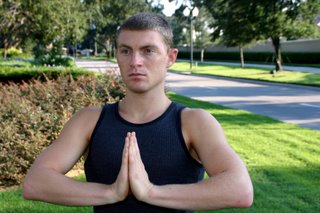 Yoga for men Guys have the world to gain by practicing yoga. So what’s holding them back?
It’s a beautiful Saturday morning and I am in, of all places, a yoga studio. While my cycling buddies set out for a ride, I waited by racks of flowery yoga clothes, then filed in for class. While my pals pedaled and, no doubt, rapped about racing, I unrolled my black mat near someone else’s pink one, beside someone else’s painted toenails and a pile of voguish flip-flops. Now, my fellow riders are probably engaged in some testosterone-fueled sprint, while I’m grunting loudly to stay balanced on my forearms. I’m inverted and self-conscious: In a class filled with women, I alone am emitting primal noises.
A world turned upside down—that’s yoga for most of us men. We still run most of the government and hit the major league home runs, but yoga is a woman’s domain. According to a 2005 Yoga Journal market study, 77 percent of the yoga practitioners in America are female. Anecdotally, longtime teachers like Anusara Yoga founder John Friend and Power Yoga instructor Baron Baptiste, who both regularly crisscross the nation hosting workshops, believe the numbers might be even more skewed. After all, only about 1 in 10 subscribers to this magazine is male. “What I find myself constantly contemplating,” says Michael Lechonczak, a yoga instructor who teaches at Equinox Fitness in Manhattan, “is how to get more guys into class.”
It’s not that we don’t know what we’re missing. Nowadays, there seems to be a yoga studio on every corner; our girlfriends and wives are walking, talking testimonies to the practice. At home, we watch them rushing out the front door, brows furrowed, only to return standing tall, with big, tranquil smiles on their faces and compassion in their eyes. Because my wife Madeleine is a yoga instructor and an avid student, I witness this stress-to-bliss transformation several times a week. When she comes home, I often mumble to myself, “Don’t I want to be that happy?” Yet I haven’t practiced yoga consistently for years.
So I asked highly qualified doctors, scientists, and veteran yoga teachers exactly why so many men stick to yoga’s sidelines. I also polled members of that rare breed known as the male practitioner—from pro athletes to busy investment managers—to find out how they came to embrace yoga. In the end, I discovered social, physical, and emotional realities that discourage men from practicing. I also heard about the moments of inspiration that got men over such barriers—and ideas about what might help other men make the leap, too. If you’re a man who’s hesitated to try yoga—or you know a man you’d like to introduce to the practice—read on.
Social Obstacles: Yoga Takes a Brave Man
Getting men to identify with yoga has long been a challenge in this country. It doesn’t matter that yoga, since its beginnings in India thousands of years ago, has mainly been taught and studied by men. Restrictive American immigration laws of the early 1900s stunted the spread of Indian culture on these shores, and only a handful of influential yogis arrived here through the decades. One such important teacher was Indra Devi. Russian born and Indian taught, she came to the United States in the 1940s and was championed by none other than celebrity cosmetologist Elizabeth Arden. That name resonated, of course, with the women who gobbled up her products, and Arden encouraged her customers to try yoga. A few years later, teacher Richard Hittleman published yoga books and landed on TV—but always had women perform the poses. Yoga’s next media celebrity was a young instructor named Lilias Folan, who began teaching asanas on public television in the 1970s. Folan had a gentle style that empowered millions of stay-at-home moms to follow right along. By the time Power Yoga emerged in the 1980s and began attracting more men, the mainstream view of the practice had, fairly or not, taken root: Yoga was for housewives.
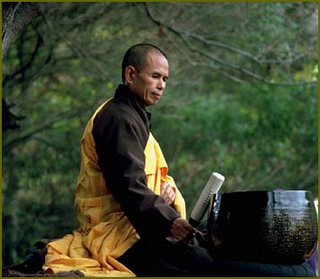 Thich Nhat Hanh Sure enough, the first thing many men notice on entering a yoga studio is that they’re in foreign territory. Pensive women readying for class sets as strong a tone as a locker room of guys snapping towels. “Men walk in needing a challenge,” says Judith Lasater, who has authored six yoga books during her 35 years as a teacher. “Women often come to the mat seeking refuge.”
The instructor can be equally alien. A female teacher might seem like just another pretty face in the intimidating crowd. A male teacher, who will likely be more humble and sensitive than your average tough-love personal trainer, may be met with disdain. “A student walks in from corporate America, and he encounters this man who exists in such a different realm,” Baptiste says. “The instructor might not be a guy’s guy.”
Lechonczak, who consulted on the book Real Men Do Yoga, sympathizes with such concerns. Before coming to the practice nearly 20 years ago, he had a consuming business career and was a weekend warrior who ran and played basketball. Lechonczak thinks more men might be willing to try yoga if they perceived it as yet another test. Albeit a unique one. “The guys coming to yoga have to be ready for the next level, be ready to let down their defenses,” he says. “They have to have heart.”
A guy’s first act of yogic bravery, Lechonczak says, is to introduce himself to the teacher. “Find out if the class is appropriate,” he advises. “Admit any fears or anxieties.”
Once the line of communication is open, a good instructor will tailor a class for individual students—male or female. Scott Achelis, a 54-year-old general contractor in Walnut Creek, California, began taking classes locally early last year because his back was tweaked from decades of construction work. The key was a positive first experience at the Yoga & Movement Center: a men’s only, one-day workshop held by studio director Diane Valentine. Her agenda? Make it fun, and let guys be guys. “It was unthreatening,” Achelis says. “We were all stretching and making off-color jokes.”
Achelis quickly became a regular in a coed class. “It’s still difficult for me when I’m partnered with a woman. I’m uncomfortable touching anybody who’s not my wife the way you have to in yoga,” he admits. But otherwise being a man among women no longer bothers him. He couldn’t care less who’s in the room, or that some very unathletic-looking females can enter poses that he can’t. “I don’t feel like I’m doing 10 percent of something being done by a woman next to me,” Achelis says. “I’m doing 100 percent of what I’m able to do.”
Physical Hurdles: Overcoming Groins and Gray Matter
Get a man past his reservations about asana time with the ladies and he’ll still have a well-founded reason to drag his feet to a studio: Yoga can be painful.
Men, it seems, are naturally tight. Boys and girls may be born equally limber, with an ability to comfortably put their feet behind their heads. But by adolescence, boys generally lose flexibility faster than girls, and as boys become men, the differences in flexibility tend to grow. Researchers have noted this gap, although they can’t specifically link it to differences in hormones, musculature, or connective tissue. “It’s hard to attribute to any one thing,” says Lynn Millar, a professor of physical therapy at Andrews University in Berrien Springs, Michigan.
Whatever is to blame, the typical man’s pursuits and lifestyle, from sitting at a desk all day to grabbing beers after a twilight softball game, put little importance on flexibility.
Lasater says stretching takes a back seat in a male’s life as early as high school. “Look at the way they stretch in football—they push on each other and bounce. It hurts,” she says. “How could anyone emerge from that with a positive view of flexibility?” Investment manager Ron Bernstein was certainly ambivalent about stretching—until his 80-hour workweeks caught up with him. Back in 1998, Bernstein, a former competitive high school golfer who’s a managing director for the investment firm Marathon Real Estate in New York City, realized that “everything hurt,” he says. “My wife was doing some yoga and suggested that stretching would be good.”
Bernstein, 37, went to a class in lower Manhattan and muddled through. “On my walk home, my back felt so much better. All those Upward and Downward Dogs really worked.”
Physical Benefits
Today a more limber Bernstein is religious about his one-day-a-week private sessions. He attributes his daily vitality and still-strong golf game to Warrior Pose variations that open his shoulders, hips, and back. “My handicap was 10 as a kid and I’m still at about 13,” he says. “Not bad for a guy who works all the time.” Elasticity also helps men who are determined to play all day. Barry Zito, the 28-year-old star pitcher who’s spent most of his career with the Oakland A’s, serves as a role model for any jock who’s determined to stay injury free. Building up muscle mass and repeating the same athletic motions day after day and year after year only adds to a body’s tightness. Which is all the more reason why Zito, who’s been in the majors since 2000, likes to brag about a statistic other than wins and losses. “I’ve never missed a start,” he says.
Zito began practicing yoga in 1998, when he heard about an off-season training program in Southern California that entwined baseball skills with yoga—”I’ve always been open to alternative forms of training,” he says—and he’s been doing asanas ever since.
Zito’s daily regimen usually includes groin and hip openers like Pigeon, Frog, and Warrior poses because “they’re kind of like the positions I find myself in when I’m pitching,” he says. Zito happily demonstrates poses to his fellow major leaguers, although in the good ol’ boy world of professional baseball, he keeps plenty to himself. “It’s too foreign for them,” he says. Zito believes, however, that such myopia may prevent players from staying in the lineup.
“Some guys aren’t willing to do the things required to keep their health,” Zito says. “I’m not judging anyone. I just know my own experience, and it’s been really, really good.”
Zito might have an even harder time spreading the gospel of yoga if men knew that, when it comes to life on the mat, their brains as well as their bodies are working against them. Science hasn’t concluded that women have higher IQs. But women can boast about their mirror neurons.
These are brain cells that receive signals from another person and trigger similar reactions in the observer. Watching someone cry, for example, might more easily cause you to cry. While mirror neurons often detect emotions, they also help an observer match posture and breathing. “You use mirror neurons to watch and imitate your yoga instructor,” says Louann Brizendine, a neuropsychiatrist at the University of California at San Francisco and the author of The Female Brain.
For men, says Brizendine, the catch is that they don’t respond as well as women to such transmitted signals. Scientists are still speculating whether women have more of such cells, or just more active ones. Either way, the neurons don’t inherently make women superior jocks, since men may have been born or raised with other athletic advantages. “But because females’ mirror neurons are more easily activated,” Brizendine says, “on average, women can mimic better than men.”
Fortunately, men can raise the performance of their mirror neurons if they consistently employ them. But until then, men enter the yoga studio at a disadvantage. New poses will be harder for them to get right. “The instructors need to be more patient with the male students,” Brizendine says. “They have to perform more demonstrations for them.”
Emotional Challenge: Try Beating Yourself
Even if a guy turns a physical corner and starts adapting to yoga’s demands, he may still miss out on many of the practice’s benefits. Yoga’s internal rewards—everything from better focus to less stress—are the hardest for men to realize.
Brizendine says that this problem, too, begins with men’s wiring. Men’s brains have a high capacity to process emotions like fear and aggression. Put an average, aggressive-feeling man on the mat, add thoughts about hostile takeovers or Shaq dunking a basketball, and you get someone who isn’t looking to quiet his mind but to let go of pent-up energy. That’s easy in traditional recreational sports, with their scores, times, and rivalries. But guys in Downward Dog may still be looking for something, or someone, to beat. “For men, physical activity—nonsexual physical activity—has always been closely associated with competition,” Brizendine says. “Studies have shown that for the last 40 years.”
Brizendine adds that with time and training, men’s brains can get past such competitive urges, and the proof lies in the men who have found enormous benefits from tapping into yoga’s more emotional offerings. Bill Gross, chief investment officer for asset management company Pimco and one of the most powerful men in his business, appreciates what 12 years of yoga has done for his head. Every morning, Gross, 62, leaves his Southern California office to gather his thoughts in a gym. Part of the workout always includes yoga. Gross loves doing Headstand. “Some of my best ideas come during Sirsasana,” he says. And, he adds, often after his routine, “a light bulb turns on, and I’m on to something.”
Away from the multiple computer screens and trading-room hubbub, Gross gets more than inspiration. The mat offers him a place to calm his nerves and breathe deeply. He returns to the office rejuvenated and relaxed, ready to work with a purpose. “Focus is a huge part of what I do,” Gross says, “and when you are trusted with nearly $700 billion of other people’s money, you’d better be focused. Because of my practice, I can sift the noise from the facts of an investment.”
Yoga can also teach a guy who’s overwhelmed by his many responsibilities that the best way to get things done is by being present—focusing on one thing at a time.
“If I go from breath to breath, I’ll find myself at the end of class,” says Zito. Similarly, when he’s playing a game, he says, “If I go hitter to hitter as opposed to letting my mind drift, I’ll suddenly be in the seventh inning.”
Men, like women, can get addicted to yoga’s emotional benefits. Mehmet Oz, a surgery professor at Columbia University who promotes holistic wellness in his book Healing from the Heart, is also a sports nut. But the doctor, who played football at Harvard and has a basketball court in his basement, sees his daily yoga practice as an escape, whether it’s from surgery or scorekeeping.
“That’s where the freedom comes in. You can let go,” he says. “You realize that the bigger game you’re playing in life isn’t about competitiveness.”
What life is about, Oz says, is awareness, equanimity, and keeping one’s ego in check—after all, the world is a bigger place than any one…man. Indeed, in topping off the list of yoga’s benefits for his male colleagues, Oz even uses the word “spirituality,” although he’s aware that some men might find that term a turnoff. “Try to get a man in contact with the spiritual element of yoga right from the start, and he’ll be lost,” he says. “He isn’t ready for that.”
Bernstein, the investment manager who has practiced yoga for seven years, admits that he still doesn’t like “chanting Om too many times and closing my eyes.” But these days Bernstein’s biggest problem concerning yoga is an inability to share his experiences with the very wife who persuaded him to try it. She abandoned yoga eight years ago. “I have no idea why Keri quit,” he says. “She just won’t do it.”
Maybe she needs a few more male practitioners to tell her what she’s missing.
Use our unique “Zen Clock” which functions as a Yoga & Meditation Timer. It features a long-resonating acoustic chime that brings your meditation or yoga session to a gradual close, preserving the environment of stillness while also acting as an effective time signal. Our Yoga Timer & Clock can be programmed to chime at the end of the meditation or yoga session or periodically throughout the session as a kind of sonic yantra. The beauty and functionality of the Zen Clock/Timer makes it a meditation tool that can actually help you “make time” for meditation in your life. Bring yourself back to balance.
 timer and gentle chime alarm clockyoga Adapted from Yoga Journal by Andrew Tilin
Now & Zen’s Yoga Timer Store
1638 Pearl Street
Boulder, CO 80302
(800) 779-6383
Posted in yoga, Yoga Timer, Yoga Timers by Now & Zen
 share your yoga practice with your children One way you can introduce yoga to your children is through a regular kids’ yoga class. But if one doesn’t fit in your family’s schedule, or the right teacher hasn’t appeared, no worries. To offer your kids a meaningful experience of yoga, all you have to do is make it a part of your home life.
Kate Holcombe, founder and president of the Healing Yoga Foundation in San Francisco, met her teacher, T.K.V. Desikachar, when she was 19. During her many years of study with him in Chennai, India, she noticed that the legendary yogi didn’t practice behind closed doors; he practiced out in the open, with his family.
So when Holcombe had her own children, she followed her teacher’s adage: “Yoga is for the living room, not the yoga room.” She invites her oldest sons (Calder, 8, and Hayes, 5) to use her body as a playground while she’s practicing asana. “They love doing my stretches with me,” she says. “When I’m in Downward Dog, they race underneath me as many times as they can before I move into Upward Dog. While I’m on my back with my legs in the air, they jump up and fly like an airplane on my feet.” Holcombe has taught Calder to do Sun Salutations, and he and Hayes like to imitate postures by her side. Sometimes, at night, when she does her asana routine in their bedroom, they watch her in the shadows and listen to the sound of her breathing as they fall asleep. Her advice for parents? “Rather than compartmentalizing ‘yoga time’ and ‘family time,’ be flexible,” she says. “Adapt your practice to your lifestyle and your children’s needs.” Her sons know that they can join their mom for postures and chanting when they’re in the mood, but it’s never required.
As you create your home routine, says Pandit Rajmani Tigunait, the spiritual head of the Himalayan Institute in Honesdale, Pennsylvania, and a longtime student of Swami Rama, it’s important to teach only what you practice. If you love vinyasa classes, show your children flowing sequences that are coordinated with the breath. If you sit for long periods of meditation, invite your child to crawl onto your lap for as long as she’s comfortable being still. If you have an altar, let your child pick flowers or draw pictures to place on it. “Let your children see that your practice makes you happy,” he says, “and let them follow you.”
With positive role modeling and regular firsthand experience, he says, your kids will begin to see that yoga—in all its myriad forms—is good for their health, happiness, and spiritual development. And as they mature, they may be inspired to study in a more structured manner.
adapted from Yoga Journal by By Shannon Sexton
 Meditation and Yoga timers and tools Now & Zen
1638 Pearl Street
Boulder, CO 80302
(800) 779-6383
Posted in yoga, Yoga Timer, Yoga Timers by Now & Zen
 Hugging Meditation At a recent lecture, I led a group of interfaith seminarians in the contemplation of the Five Remembrances, Buddha’s teaching on impermanence, aging, health, change, and death. Afterward, one of the students asked, “Isn’t this just negative thinking?” On the contrary, the Five Remembrances is what the Buddha offers to awaken you from denial, to cultivate gratitude and appreciation for the life you’ve been given, and to teach you about nonattachment and equanimity.
Another way of practicing the Five Remembrances is through something Buddhist master Thich Nhat Hanh calls hugging meditation. When your partner or children leave for work or school, hug each other for three full breaths, and remind yourself of the Fourth Remembrance: “All that is dear to me and everyone I love are of the nature to change. There is no way to escape being separated from them.” If you’re having a disagreement with someone, remind yourself, before getting swept away by heated emotions, of the Fifth Remembrance: “My actions are my only true belongings. I cannot escape the consequences of my actions. My actions are the ground upon which I stand.” None of this means you should be passive or reluctant to advocate your views. Instead the meditation helps you respond more skillfully with awareness of how things truly are rather than from conditioned reactions.
adapted from Yoga Journal by Frank Jude Boccio
 tibetan bowl alarm clocks and timers for meditation and yoga
Now & Zen
1638 Pearl Street
Boulder, CO 80302
(800) 779-6383
Posted in yoga, Yoga Timer, Yoga Timers by Now & Zen
 meditation for children Our students in the post-pubertal stage of adolescence can engage in more classical forms of meditation. We can teach them techniques that further support their mental development, for example, so that they can stay relaxed and able to concentrate during these most important learning years.
Again, one of the best practices to teach is yoga nidra. This time we can use the adult form, rotating the awareness through the body parts and then taking awareness deeper into the breath and mind.
Visualization techniques are wonderful for this age group, and techniques that develop memory and mental power are particularly useful. For example, we can ask a child to visualize an imaginary blackboard and ask them to see themselves writing the letters of the alphabet on this board in colored chalk. Or in this day and age, to visualize a computer screen and see themselves creating their own computer game, following their hero through any story they want to create.
Breath meditations are useful for helping students who are at home studying. It is important for students to remain relaxed and receptive, and to take regular productive and relaxing breaks from study. They can, if they wish, use that time to mentally review their work.
By Swami Shankardev Saraswati, Ph.D
 meditation timers and alarm clocks with chimes
Now & Zen
1638 Pearl Street
Boulder, CO 80302
(800) 779-6383
Posted in yoga, Yoga Timer, Yoga Timers by Now & Zen
 meditation for children By the age of eight, a child’s fundamental personality has formed and his or her body begins a process of preparing for puberty. Changes begin to occur in children’s brains around the age of eight, and these changes reach a peak during puberty. When we teach meditation to this age group, our main aim is to support balanced physical and mental development. This helps the child be better mentally prepared for the onslaught of feelings, desires, and urges that arise during puberty. It also supports the child’s ability to take in knowledge at school, and to develop a relaxed focus and good memory.
Eight-year-olds in India learn three practices to foster total physical, mental, and spiritual development. These are Sun Salutation for the body, alternate nostril breathing for the brain and mind, and mantras for the deeper mind and spirit. These practices can slow the onset of puberty and balance its effects by acting on the subtle channels that flow in the spine. Mental development then has time to catch up to physical changes.
Yogic physiology explains how this occurs. A child’s physical changes during puberty are under the control of pingala nadi, the spinal channel that carries prana, the life force. Mental development occurs under the control of ida nadi, the spinal channel that carries psychological force. Excessive stimulation of the physical channel alone, as tends to occur in the normal social environment, causes imbalanced development and can make puberty a rough process. The yogic practices taught children at this time stimulate both channels equally, to stimulate physical and mental growth at the same time.
The practice of Sun Salutation balances the life force, prana, preventing it from becoming jammed up in the sexual centers (swadhisthana chakra). One note of caution is to teach children only asanas that are playful and that do not put too much pressure on the endocrine system. Never hold the major poses for extended periods, as they will overstimulate the physical systems and can cause imbalanced development.
Alternate nostril breathing is a pre-meditative practice that balances the flow of energy in both ida and pingala. This pranayama directly affects the physical and mental systems by balancing both sides of the brain. Do not teach breath retention to children. Simply get them to observe the flow of the breath in on one side and out on the other, alternating sides. This will calm and balance them.
Mantras are the main meditative practices taught to this age group, as they powerfully affect the brain and its development. The main mantra taught is the Gayatri mantra. This mantra has 24 syllables, each of which stimulates a different part of the brain. Gayatri is the mantra to stimulate our intelligence.
All of the practices listed above, including yoga nidra as detailed for younger children, will support a child’s ability to learn, to take in and digest information at school, and to develop individual interests.
adapted from Yoga Journal by Swami Shankardev Saraswati, Ph.D.
 Maple Meditation Timer with Chime Now & Zen
1638 Pearl Street
Boulder, CO 80302
(800) 779-6383
Posted in yoga, Yoga Timer, Yoga Timers by Now & Zen
 teaching meditation to children From the point of view of yogic physiology, children below age eight do not need much formal meditation training. It is more important for these children that their parents learn yoga and meditation and carry yogic principles into their homes. Children absorb the energy of the environment. If their parents practice some form of self-development, their children will grow up in a healthier, more relaxed and aware environment.
Parents need to practice meditation techniques that increase their own capacity for awareness in the midst of their busy lives, so that they can be more present and available to their children. The child needs to know that a parent is really interested in them, is really listening to and attending to them. At the same time, parents need to learn how to allow children to be themselves and to foster each child’s own unique being and abilities.
One meditation technique can be used with children in this age group, however. A modified practice of yoga nidra is a deep relaxation practice in the Corpse Pose (Savasana). In this practice we cannot ask the children to feel individual parts of the body, but rather we work with awareness of larger parts. For example, we may playfully instruct the child in body awareness by saying, “Feel that you are a statute until I count to 10. Now bend your elbows and now straighten your arms.” We give similar instructions with the legs and may ask them to wiggle their toes, and so on. This takes their awareness through the body.
Once children have developed a little body awareness, we can teach them to listen to and follow outside sounds, or to visualize imaginary realms, or we can read stories that stimulate their imaginations.
adapted from Yoga Journal, by Swami Shankardev Saraswati, Ph.D
Use our unique “Zen Clock” which functions as a Yoga Timer. It features a long-resonating acoustic chime that brings your meditation or yoga session to a gradual close, preserving the environment of stillness while also acting as an effective time signal. Our Yoga Timer & Clock can be programmed to chime at the end of the meditation or yoga session or periodically throughout the session as a kind of sonic yantra. The beauty and functionality of the Zen Clock/Timer makes it a meditation tool that can actually help you “make time” for meditation in your life. Bring yourself back to balance.
 yoga & meditation supplies, timers and clocks Now & Zen – The Yoga Timer Store
1638 Pearl Street
Boulder, CO 80302
(800) 779-6383
Posted in yoga, Yoga Timer, Yoga Timers by Now & Zen
 teaching meditation to kids When we teach meditation to children, we need to choose age-appropriate techniques that foster their total growth and development. The word “meditation” is an English term for a wide range of practices and techniques. Meditations for children cannot be the same as those taught to middle-aged business people or spiritual aspirants seeking higher knowledge. Rather, in this context, meditation is a process that supports the growth of the body-mind of the child, fosters the development of each child’s own unique personality, and supports creativity and expression.
Meditation techniques for children can help them relax and focus better during school, so that they can concentrate and memorize more effectively. From the spiritual perspective, good meditation techniques teach children self-awareness, encourage them to be themselves, and help them face life with greater belief in their potential.
adapted from Yoga Journal by Swami Shankardev Saraswati, Ph.D
 meditation supplies, timers and clocks Now & Zen
1638 Pearl Street
Boulder, CO 80302
(800) 779-6383
Posted in yoga, Yoga Timer, Yoga Timers by Now & Zen
« Previous Page — « Previous Entries
Next Entries » — Next Page »
|
|
|
|